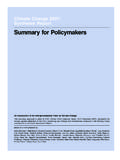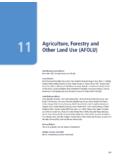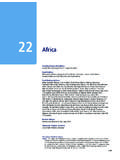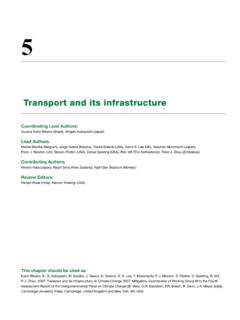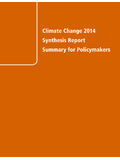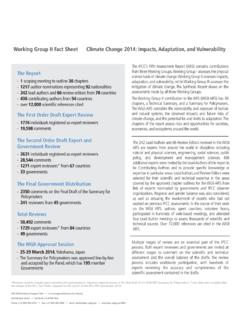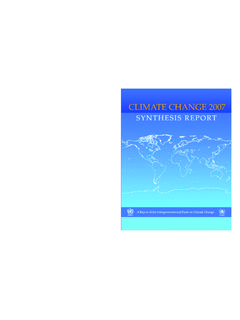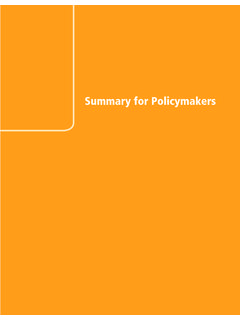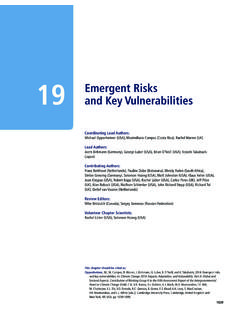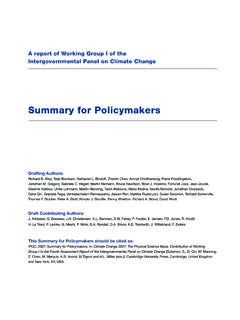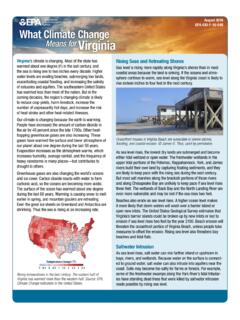Transcription of 3 — Freshwater Resources
1 2293 Freshwater ResourcesCoordinating Lead Authors:Blanca E. Jim nez Cisneros (Mexico), Taikan Oki (Japan)Lead Authors:Nigel W. Arnell (UK), Gerardo Benito (Spain), J. Graham Cogley (Canada), Petra D ll(Germany), Tong Jiang (China), Shadrack S. Mwakalila (Tanzania)Contributing Authors:Thomas Fischer (Germany), Dieter Gerten (Germany), Regine Hock (Canada), Shinjiro Kanae(Japan), Xixi Lu (Singapore), Luis Jos Mata (Venezuela), Claudia Pahl-Wostl (Germany),Kenneth M. Strzepek (USA), Buda Su (China), B. van den Hurk (Netherlands)Review Editor:Zbigniew Kundzewicz (Poland)Volunteer Chapter Scientist:Asako Nishijima (Japan)This chapter should be cited as:Jim nez Cisneros, , T. Oki, Arnell, G. Benito, Cogley, P. D ll, T. Jiang, and Mwakalila, 2014: Freshwater Resources . In: Climate Change 2014: Impacts, Adaptation, and Vulnerability. Part A: global andSectoral Aspects. Contribution of Working Group II to the Fifth Assessment Report of the IntergovernmentalPanel on Climate Change[Field, , Barros, Dokken, Mach, Mastrandrea, Bilir,M.]
2 Chatterjee, Ebi, Estrada, Genova, B. Girma, Kissel, Levy, S. MacCracken, Mastrandrea, and White (eds.)]. Cambridge University Press, Cambridge, United Kingdomand New York, NY, USA, pp. Introduction .. Observed Hydrological Changes Due to Climate Change ..234 Detection and Attribution ..234 Precipitation, Evapotranspiration, Soil Moisture, Permafrost, and Glaciers ..236 Streamflow ..236 Groundwater ..237 Water Quality ..237 Soil Erosion and Sediment Load ..237 Extreme Hydrological Events and their Impacts .. Drivers of Change for Freshwater Resources ..240 Climatic Drivers ..240 Non-Climatic Drivers .. Projected Hydrological Changes ..241 Methodological Developments in Hydrological Impact Assessment ..241 Evapotranspiration, Soil Moisture, and Permafrost.
3 241 Box 3-1. Case Study: Himalayan Glaciers ..242 Glaciers ..243 Runoff and Streamflow ..243 Groundwater ..243 Water Quality ..246 Soil Erosion and Sediment Load ..246 Extreme Hydrological Events (Floods and Droughts) .. Projected Impacts, Vulnerabilities, and Risks ..248 Availability of Water Resources ..248 Water Uses ..251 ..251 Production ..252 Services ..252 Ecosystems ..253 Uses ..253 Table of Contents231 Freshwater Resources Chapter Adaptation and Managing Risks ..253 Options.
4 254 Dealing with Uncertainty in Future Climate Change ..254 Costs of Adaptation to Climate Change ..256 Adaptation in Practice in the Water Sector .. Linkages with Other Sectors and Services ..257 Impacts of Adaptation in Other Sectors on Freshwater Systems ..257 Climate Change Mitigation and Freshwater Systems ..257 of Climate Change Mitigation on Freshwater Systems ..257 of Water Management on Climate Change Mitigation .. Research and Data Gaps ..258 References ..259 Frequently Asked Questions : How will climate change affect the frequency and severity of floods and droughts? ..247 : How will the availability of water Resources be affected by climate change? ..251 : How should water management be modified in the face of climate change? ..253 : Does climate change imply only bad news about water Resources ?
5 257232 Chapter 3 Freshwater Resources3 Executive Summary Key Risks at the global ScaleFreshwater-related risks of climate change increase significantly with increasing greenhouse gas (GHG) concentrations (robustevidence, high agreement). { , } Modeling studies since AR4, with large but better quantified uncertainties, have demonstrated cleardifferences between global futures with higher emissions, which have stronger adverse impacts, and those with lower emissions, which causeless damage and cost less to adapt to. {Table 3-2} For each degree of global warming , approximately 7% of the global population is projectedto be exposed to a decrease of renewable water Resources of at least 20% (multi-model mean). By the end of the 21st century, the number ofpeople exposed annually to the equivalent of a 20th-century 100-year river flood is projected to be three times greater for very high emissions(Representative Concentration Pathway ( )) than for very low emissions ( ) (multi-model mean) for the fixed population distri-bution at the level in the year 2005.
6 {Table 3-2, }Climate change is projected to reduce renewable surface water and groundwater Resources significantly in most dry subtropicalregions (robust evidence, high agreement). { , } This will intensify competition for water among agriculture, ecosystems,settlements, industry, and energy production, affecting regional water, energy, and food security (limited evidence, mediumtohigh agreement). { , , Box CC-WE} In contrast, water Resources are projected to increase at high latitudes. Proportional changesare typically one to three times greater for runoff than for precipitation. The effects on water Resources and irrigation requirements of changesin vegetation due to increasing GHG concentrations and climate change remain uncertain. {Box CC-VW}So far there are no widespread observations of changes in flood magnitude and frequency due to anthropogenic climate change,but projections imply variations in the frequency of floods (limited evidence, medium agreement).
7 Flood hazards are projected toincrease in parts of South, Southeast, and Northeast Asia; tropical Africa; and South America (limited evidence, medium agreement). Since themid-20th century, socioeconomic losses from flooding have increased mainly due to greater exposure and vulnerability (high confidence). global flood risk will increase in the future partly due to climate change (limited evidence, medium agreement). { , }Climate change is likelyto increase the frequency of meteorological droughts (less rainfall) and agricultural droughts (less soilmoisture) in presently dry regions by the end of the 21st century under the scenario (medium confidence). {WGI AR5 Chapter 12} This is likelyto increase the frequency of short hydrological droughts (less surface water and groundwater) in theseregions (medium evidence, medium agreement). { } Projected changes in the frequency of droughts longer than 12 months are moreuncertain, because these depend on accumulated precipitation over long periods.
8 There is no evidence that surface water and groundwaterdrought frequency has changed over the last few decades, although impacts of drought have increased mostly due to increased water demand.{ }Climate change negatively impacts Freshwater ecosystems by changing streamflow and water quality (medium evidence, highagreement). Quantitative responses are known in only a few cases. Except in areas with intensive irrigation, the streamflow-mediatedecological impacts of climate change are expected to be stronger than historical impacts owing to anthropogenic alteration of flow regimes bywater withdrawals and the construction of reservoirs. {Box CC-RF, }Climate change is projected to reduce raw water quality, posing risks to drinking water quality even with conventional treatment(medium evidence, high agreement). The sources of the risks are increased temperature, increases in sediment, nutrient and pollutantloadings due to heavy rainfall, reduced dilution of pollutants during droughts, and disruption of treatment facilities during floods.
9 { , Figure 3-2, , }In regions with snowfall, climate change has altered observed streamflow seasonality, and increasing alterations due to climatechange are projected (robust evidence, high agreement). {Table 3-1, , , , , } Except in very cold regions, warming in the last decades has reduced the spring maximum snow depth and brought forward the spring maximum of snowmelt discharge;smaller snowmelt floods, increased winter flows, and reduced summer low flows have all been observed. River ice in Arctic rivers has beenobserved to break up earlier. { , }2333 Freshwater Resources Chapter 3 Because nearly all glaciers are too large for equilibrium with the present climate, there is a committed water Resources changeduring much of the 21st century, and changes beyond the committed change are expected due to continued warming ; in glacier-fed rivers, total meltwater yields from stored glacier ice will increase in many regions during the next decades but decreasethereafter (robust evidence, high agreement).
10 Continued loss of glacier ice implies a shift of peak discharge from summer to spring, exceptin monsoonal catchments, and possibly a reduction of summer flows in the downstream parts of glacierized catchments. { }There is little or no observational evidence yet that soil erosion and sediment loads have been altered significantly due tochanging climate (limited evidence, medium agreement). However, increases in heavy rainfall and temperature are projected to changesoil erosion and sediment yield, although the extent of these changes is highly uncertain and depends on rainfall seasonality, land cover, andsoil management practices. { , }Adaptation, Mitigation, and Sustainable DevelopmentOf the global cost of water sector adaptation, most is necessary in developing countries where there are many opportunitiesfor anticipatory adaptation (medium evidence, high agreement).There is limited published information on the water sector costs ofadaptation at the local level.
